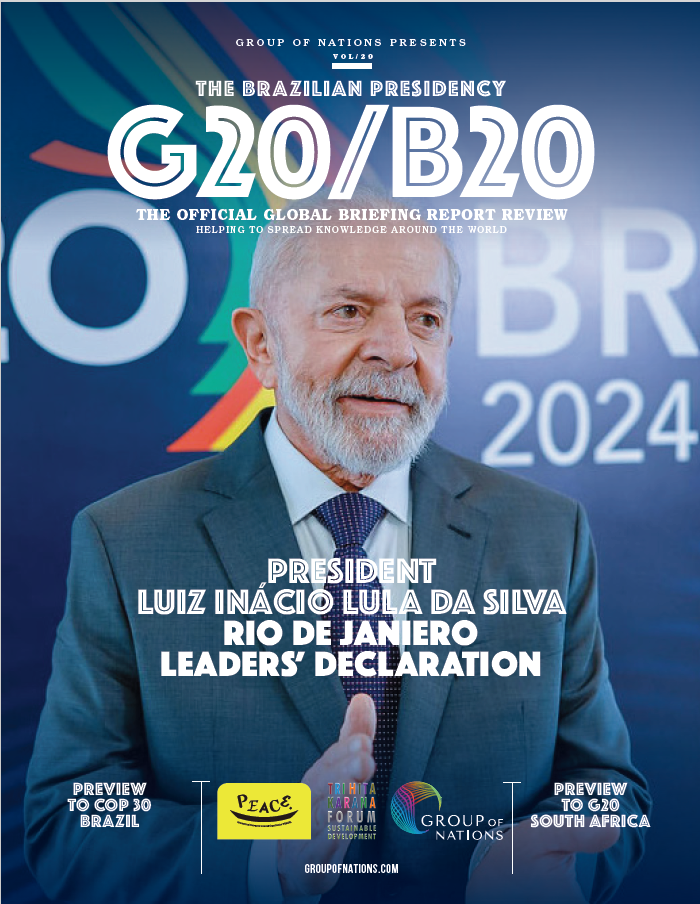
The G20/B20 Global Briefing Report Review: Brazil Issue is a comprehensive, high-level publication designed to capture the key themes, outcomes, and opportunities emerging from Brazil’s presidency of the G20 in 2024. As Rio de Janeiro takes center stage as the host city, this issue provides exclusive insights into the priorities, challenges, and innovations shaping the global agenda. Key Features: Official Collaboration: Produced in partnership with summit organizers and key stakeholders, including the B20 and AUDA-NEPAD, ensuring authoritative content and strategic distribution. Summit Highlights: In-depth analysis of Brazil’s leadership priorities—sustainable development, climate finance, infrastructure investment, gender equality, and the empowerment of Indigenous peoples. Expert Commentary: Contributions from world leaders, CEOs, policymakers, and international organizations, offering diverse perspectives on global governance and economic refom.

Widely acclaimed as the progenitor oftwentieth-century Latin American fiction, Machado de Assis (1839-1908) - theson of a mulatto father and a washerwoman, and the grandson of freed slaves - washailed in his lifetime as Brazil's greatest writer. Born in the outskirts ofRio, Machado displayed a precocious interest in books and languages and,despite his impoverished background, miraculously became a well-knownintellectual figure in Brazil's capital by his early twenties. Predominantlyset in the late nineteenth-century aspiring world of Rio de Janeiro - a city inthe midst of an intense transformation from colonial backwater to imperialmetropolis - the postcolonial realism of Machado's stories anticipates adominant theme of twentieth-century literature. Readers witness the bourgeoisieof Rio both at play, and, occasionally, attempting to be serious, as depictedby the chief character of "The Alienist," who makes naively grandioseclaims for his Brazilian hometown at the expense of the cultural capitals ofEurope. Signifiers of new wealth and social status abound through the landmarksthat populate Machado's stories, enlivening a world in the throes oftransformation: from the elegant gardens of Passeio Público and the vibrant Ruado Ouvidor - the long, narrow street of fashionable shops, theaters and cafés,"the Via Dolorosa of long-suffering husbands" - to the port areas ofSaúde and Gamboa, and the former Valongo slave market

Policarpo Quaresma - fastidious civil servant,dedicated patriot, self-styled visionary - is a defender of all thingsBrazilian, full of schemes to improve his beloved homeland. Yet somehow each ofhis ventures, whether it is petitioning for Brazil's national language to bechanged, buying a farm to prove the richness and fertility of the land, oroffering support to government forces as they suppress a military revolt -results in ridicule and disaster. Quixotic and hapless, Quaresma's dreams willeventually be his undoing. Funny, despairing, moving and absurd, Lima Barreto'smasterpiece shows a man and a country caught in the violent clash betweenillusion and reality, hope and decline, sanity and madness. The narrative takesplace in the city of Rio de Janeiro, in the first years of the Republic

Along with Machado de Assis and Lima Barreto,Paulo Barreto, a mulatto man, just like the other two, makes up the best urbanprose's trio from the beginning of the 20th century. This novelist, who wasalso a storyteller, a journalist, a playwright, a chronicler, a lecturer, andan essayist, took the blending of reporting and literary chronicles to its lastconsequences, innovating on the writing produced at the time. It is not falseto say that the belle-époque Rio de Janeiro was indeed an invention of thisman, who is the best example of the Brazilian art nouveau literature. His lifeand work fuses with the city, whose multiple aspects he portrayed so well.Attending from important presidential receptions to spiritualist congregationsin the outskirts of the city, as well as samba parties in the slums of Rio deJaneiro, he mingled with the crowd to describe the routine of the downtroddenpeople of the time. In addition to the color of his skin, already a reason fordiscrimination, his homosexuality defied the standards. But he did not becomepopular as Paulo Barreto, but rather as João do Rio, one of his many pennames